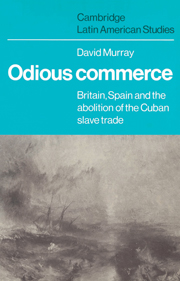Book contents
- Frontmatter
- Contents
- Tables
- Preface
- 1 The ‘opening’ of a legal trade
- 2 Parliament versus Cortes
- 3 Legality and illegality
- 4 The treaty of 1817
- 5 Enforcement and re-enforcement: the attempt to make the slave trade prohibition effective
- 6 The treaty of 1835
- 7 An abolitionist era
- 8 The Turnbull affair
- 9 The Escalera conspiracy
- 10 The penal law of 1845
- 11 Free trade and annexationism
- 12 The failure of the penal law
- 13 A new class of slaves
- 14 The abolition of the Cuban slave trade
- Abbreviations
- Notes
- Bibliography
- Index
- CAMBRIDGE LATIN AMERICAN STUDIES
14 - The abolition of the Cuban slave trade
Published online by Cambridge University Press: 16 October 2009
- Frontmatter
- Contents
- Tables
- Preface
- 1 The ‘opening’ of a legal trade
- 2 Parliament versus Cortes
- 3 Legality and illegality
- 4 The treaty of 1817
- 5 Enforcement and re-enforcement: the attempt to make the slave trade prohibition effective
- 6 The treaty of 1835
- 7 An abolitionist era
- 8 The Turnbull affair
- 9 The Escalera conspiracy
- 10 The penal law of 1845
- 11 Free trade and annexationism
- 12 The failure of the penal law
- 13 A new class of slaves
- 14 The abolition of the Cuban slave trade
- Abbreviations
- Notes
- Bibliography
- Index
- CAMBRIDGE LATIN AMERICAN STUDIES
Summary
The year 1861 was an unlikely one for optimistic predictions about a quick end to the Cuban slave trade. In 1859, and again two years later in 1861, more slave-trading expeditions set out for Africa than at any time since 1820 when the African slave trade had been declared illegal within the Spanish empire. British estimates of slave importations into Cuba during the three years 1859–61 were the highest in forty years; a total of 79,332 African slaves had been added to the Cuban slave population, thought to number 370,553 in 1861, and there was every expectation that the Cuban slave trade would carry on at the same high level. The open participation of American ships and capital, combined with improvements in maritime technology, had transformed the African slave trade. Large steamships were supplanting smaller sailing vessels as the main carriers of slaves. The number of slaves who could be transported in a single expedition rose dramatically. Two steamships alone accounted for 3,000, or approximately 10% of the slaves introduced into Cuba in 1859; one steam vessel in 1860 brought a cargo of 1,500 African slaves.
Technological improvements also were transforming the Cuban sugar economy, increasing its productive capacity and aggravating the labour shortage which the planters traditionally had resolved through the slave trade. Cuba's sugar estates had expanded rapidly in both number and size during the middle years of the nineteenth century, an expansion which the adaptation of steam power had accelerated.
- Type
- Chapter
- Information
- Odious CommerceBritain, Spain and the Abolition of the Cuban Slave Trade, pp. 298 - 326Publisher: Cambridge University PressPrint publication year: 1981



